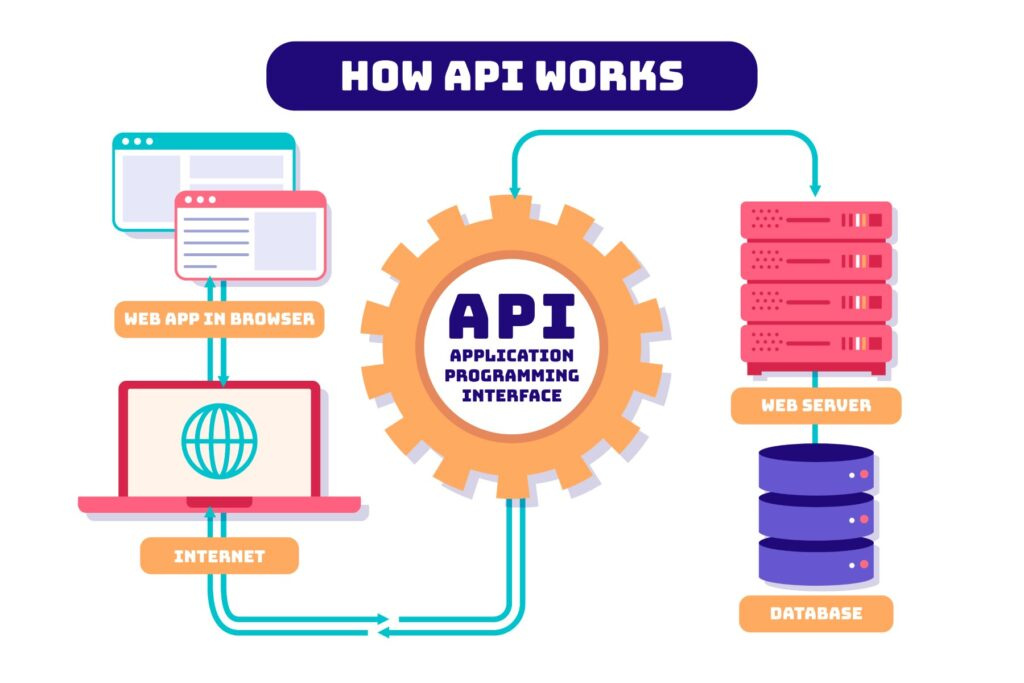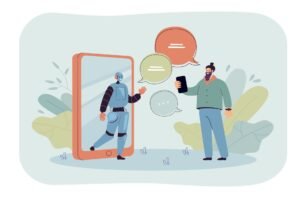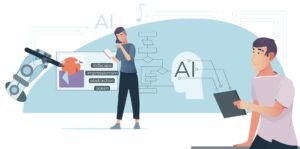In today’s tech world, connecting systems and sharing data is essential. Two tools that make this possible are APIs (Application Programming Interfaces) and MCP (Model Context Protocol). While both help systems communicate, they serve different purposes. APIs are like bridges between software apps, while MCP is a specialized tool for giving AI models the information they need to answer questions better. This article explains the differences between MCP and APIs using simple words, real-world examples, and code snippets to help you understand which to use and when.
- APIs connect software apps to share data or features, like a weather app getting updates from a server.
- MCP helps AI models, like chatbots, access specific data to give smarter answers.
- Both are important, but they work in different ways and for different goals.
- Choosing between them depends on whether you’re building general software or AI-powered tools.
On This Page
Table of Contents
What is an API?
An API is a set of rules that lets different software applications talk to each other. It’s like a menu at a restaurant: you pick what you want (data or a feature), and the kitchen (server) delivers it. APIs are used everywhere, from apps on your phone to websites and even smart devices.
For example, when you check the weather on your phone, the app uses an API to ask a weather service for the latest data. The service sends back details like temperature and rain chances, which the app shows you.
How APIs Work
- The app uses this response to display or act on the information.
- You send a request to an API (like asking for weather data).
- The server processes your request and sends back a response (like the current temperature).

API Example
Imagine you’re building a website that shows the weather. You can use a weather API to get data:
fetch('https://api.openweathermap.org/data/2.5/weather?q=Patiala&appid=YOUR_API_KEY')
.then(response => response.json())
.then(data => console.log(`Temperature: ${data.main.temp}°K`));This code asks the OpenWeather API for Patiala’s weather and logs the temperature.
What is MCP?
The Model Context Protocol (MCP) is a tool created by Anthropic to help AI models, like chatbots or virtual assistants, get the information they need to answer questions accurately. It’s designed for AI systems that need extra context, like recent data or specific tools, to respond better. Think of MCP as a librarian who finds the exact book an AI needs to answer your question.
For instance, if you ask an AI, “What’s the weather in Patiala?” it might not know unless it has recent data. MCP connects the AI to a weather service, grabs the data, and gives it to the AI to create a smart answer.
How MCP Works
- The AI (like Claude) needs extra information to answer a question.
- It uses an MCP client to ask an MCP server for the data.
- The server gets the data (e.g., from a weather API) and sends it back as context.
- The AI uses this context to give a clear, accurate response.
MCP Example
Here’s how you might set up an MCP tool to help an AI get weather data:
import { MCPServer } from 'model-context-protocol';
const server = new MCPServer();
server.registerTool({
name: 'getWeather',
description: 'Fetches weather data for a city',
inputSchema: { city: 'string' },
async execute({ city }) {
const response = await fetch(`https://api.openweathermap.org/data/2.5/weather?q=${city}&appid=YOUR_API_KEY`);
const data = await response.json();
return {
text: JSON.stringify({
temperature: data.main.temp,
forecast: data.weather[0].description
})
};
}
});This code creates an MCP tool that the AI can use to fetch weather data for any city, like Patiala.
Key Differences Between MCP and API
Here’s a table comparing MCP and APIs to make their differences clear:
| Feature | API | MCP |
|---|---|---|
| Purpose | Connects software apps to share data or features | Gives AI models context to answer questions better |
| Users | Developers building apps or websites | Developers creating AI tools needing external data |
| How It Works | Sends requests and gets responses (e.g., over HTTP) | AI client asks server for context, which fetches data |
| Standardization | Many types (REST, SOAP, GraphQL) | One standard for AI context |
| Data Focus | Shares raw data or functions | Provides tailored context (data, tools, prompts) |
Why These Differences Matter
- APIs are great for general app development, like building a weather app or a social media feature.
- MCP shines in AI development, where models need specific information to respond intelligently.
- APIs are widely used and flexible but can require custom setups for each service.
- MCP aims to simplify AI data access with a single standard, making it easier to connect to many sources.
Real-World Analogies
To make MCP and APIs easier to understand, let’s use analogies:
- API: Picture a vending machine. You pick an item (data), insert money (send a request), and the machine gives you the item (response). Each vending machine has its own items and rules, just like different APIs have unique endpoints and formats.
- MCP: Imagine a personal assistant helping a student with homework. The student asks a question, and the assistant searches books, websites, or even calls an expert to find the answer. The assistant then summarizes the information for the student. Similarly, MCP fetches the right context from various sources to help an AI answer your question.
Code Examples in Action
Let’s see how APIs and MCP work with a practical example: getting the weather for Patiala.
API Code Example
This code directly calls a weather API to display the temperature:
async function getWeather(city) {
const response = await fetch(`https://api.openweathermap.org/data/2.5/weather?q=${city}&appid=YOUR_API_KEY`);
const data = await response.json();
console.log(`Temperature in ${city}: ${data.main.temp}°K`);
}
getWeather('Patiala');This is simple and works well for apps that need weather data directly.
MCP Code Example
For an AI using MCP, you set up a tool that the AI can call when it needs weather data:
import { MCPServer } from 'model-context-protocol';
const server = new MCPServer();
server.registerTool({
name: 'getWeather',
description: 'Fetches weather data for a city',
inputSchema: { city: 'string' },
async execute({ city }) {
const response = await fetch(`https://api.openweathermap.org/data/2.5/weather?q=${city}&appid=YOUR_API_KEY`);
const data = await response.json();
return {
text: JSON.stringify({
temperature: data.main.temp,
forecast: data.weather[0].description
})
};
}
});
// The AI (e.g., Claude) calls this tool when asked about the weatherHere, the AI doesn’t call the API directly. Instead, MCP provides the weather data as context, which the AI uses to craft a response like, “It’s 298°K in Patiala with clear skies.”
When to Use MCP vs API
Choosing between MCP and APIs depends on your project:
- Use APIs When:
- Building apps or websites that need to connect to services, like a travel app pulling flight prices.
- You want direct access to data or features from another system, like a payment gateway.
- Working with well-known services that already have APIs, such as Twitter or Google Maps.
- Use MCP When:
- Developing AI tools, like chatbots or virtual assistants, that need external data to answer questions.
- You want a standard way to connect AI models to many data sources without custom code for each.
- Building AI apps that need to stay up-to-date with real-time information, like news or weather.
WrapUP
Both APIs and MCP are powerful tools for connecting systems, but they serve different needs. APIs are the go-to for linking software applications, making them essential for apps and websites. MCP, on the other hand, is a game-changer for AI, helping models like Claude get the context they need to shine. By understanding their differences, you can pick the right tool for your project, whether you’re building a simple app or a smart AI assistant.
FAQs
What’s the Difference Between MCP and API?
API: An API is like a menu at a restaurant, letting different software applications order data or features from each other. For example, a weather app uses a weather API to fetch temperature data from a server. APIs are general-purpose, used in apps, websites, and smart devices to share information or perform actions.
MCP: The Model Context Protocol is like a personal assistant for AI models, such as chatbots or virtual assistants. It helps AI find the exact information needed to answer questions accurately. For instance, if you ask an AI, “What’s the weather in Patiala?” MCP connects the AI to a weather service, grabs the data, and provides it as context for a smart response.
Key Difference: APIs are for connecting any software, while MCP is specifically designed for AI to access external data efficiently, making AI responses more relevant and up-to-date.
When Should I Use MCP Instead of an API?
Use MCP: Choose MCP when building AI tools that need to pull data from various sources to answer questions or perform tasks. For example, an AI customer support bot might use MCP to access a company’s product database, email system, and shipping APIs to provide comprehensive answers. MCP simplifies these connections by offering a standardized approach.
Use API: Opt for APIs when developing regular apps or websites that need to connect to specific services. For instance, a fitness tracker app might use a Google Maps API to show running routes, or a payment app might use a Stripe API to process transactions.
Real-World Example: An AI-powered virtual assistant that checks your calendar, emails, and weather forecasts benefits from MCP’s ability to integrate multiple sources seamlessly. A simple weather widget, however, only needs a single weather API.
Future Trend: As AI tools become more common, MCP is likely to gain traction for applications requiring complex data integrations, while APIs will remain essential for straightforward app connections.
Can MCP Replace APIs for AI Applications?
MCP doesn’t fully replace APIs but makes them easier for AI to use. Often, MCP relies on APIs to fetch data, then delivers it as context to the AI. For example, an MCP server might use a weather API to get data for a chatbot. MCP streamlines AI integrations, but APIs remain essential for the underlying data exchange.
How Does MCP Make AI Better Than Using APIs Alone?
MCP improves AI by:
Offering a single standard to connect to many data sources, reducing custom coding.
Providing only the needed data, making AI faster and more efficient.
Including security features like authentication to protect data. Compared to APIs, which require custom setups for each service, MCP is like a universal charger for AI, simplifying connections.
What Are the Downsides of MCP Compared to APIs?
Adoption: MCP is a newer protocol, so not all data sources or tools have MCP servers available yet. Developers may need to rely on traditional APIs for some integrations until MCP becomes more widespread.
Setup Complexity: Creating an MCP server requires some initial effort, especially for those unfamiliar with the protocol. However, Anthropic provides SDKs and pre-built servers to ease this process (Model Context Protocol GitHub).
Contrast with APIs: APIs are more established, with widespread support across services like Google, Twitter, and Stripe. They’re often easier to use for simple integrations but less efficient for complex AI needs.
Looking Ahead: As MCP adoption grows, more services are likely to offer MCP servers, reducing these limitations and making it a stronger competitor to APIs in AI contexts.
How Does MCP Compare to Other AI Tools Like LangChain or GraphQL?
MCP vs LangChain: LangChain is a framework for building AI applications with external tools, memory, and workflows. MCP focuses on standardizing data access for AI, providing a consistent way to connect to sources like databases or APIs. MCP could complement LangChain by simplifying how LangChain accesses external data, enhancing AI workflows.
MCP vs GraphQL: GraphQL is a type of API that lets apps request exactly the data they need, making it flexible for general software. MCP is AI-specific, designed to provide context (data, tools, or prompts) to AI models. Unlike GraphQL’s query-based approach, MCP uses a client-server model tailored for AI efficiency.
Other Tools: Compared to custom API integrations, MCP reduces complexity by offering a single standard. It’s also more structured than OpenAI’s function calling, which relies on custom function definitions.
What Are Real-World Examples Where MCP Is Better Than APIs?
AI Chatbot for Customer Support: A chatbot needs to access a company’s product database, email system, and shipping APIs to answer customer queries. MCP simplifies this by providing a single protocol to connect all sources, reducing custom coding compared to using separate APIs for each.
AI Coding Assistant: An AI-powered IDE, like Cursor, needs to fetch documentation, code snippets, and bug reports from tools like GitHub or Stack Overflow. MCP streamlines these integrations, making the AI more efficient than using multiple APIs.
Virtual Assistant: An assistant that checks your calendar, emails, and weather forecasts benefits from MCP’s ability to integrate multiple services seamlessly.
API Use Case: A simple weather widget only needs a single weather API to display data, making MCP unnecessary for such straightforward tasks.
Why MCP Wins: MCP excels in complex AI scenarios requiring multiple data sources, while APIs are better for single-service integrations.
Is MCP Only for Anthropic’s AI Models?
No, MCP is an open standard, so it works with any AI model, like OpenAI’s GPT or Google’s Gemini, not just Anthropic’s Claude. This openness makes it versatile for developers building AI tools across platforms.
How Will MCP Affect the Future of APIs?
Design Shift: As MCP grows, APIs may be designed with AI integration in mind, incorporating features that make them easier to use with MCP servers.
Growth of MCP Servers: More services, like Google Drive or Slack, are likely to create MCP servers, simplifying AI access to their data and reducing the need for custom API integrations.
Simplified Development: Developers may focus less on building custom API integrations and more on creating smarter AI systems, leveraging MCP’s standardized approach.
Future Vision: MCP could become as essential for AI as APIs are for software, potentially influencing API standards to support AI-driven applications.
What About Security with MCP vs APIs?
MCP Security: MCP includes built-in authentication and authorization features, making it easier to control who can access data. This standardized approach reduces security risks in AI applications.
API Security: APIs require developers to implement security measures like encryption, authentication, and rate limiting themselves, which can be complex and prone to errors.
Comparison: MCP’s security framework is like a pre-installed lock on a door, while APIs require you to build and install the lock yourself.
What’s the “M×N Problem” and How Does MCP Solve It?
The Problem: In AI development, connecting M AI tools (like chatbots or agents) to N data sources (like databases or APIs) requires M×N custom integrations, which is time-consuming and complex.
MCP’s Solution: MCP provides a single standard, reducing the need to M AI clients and N data servers, simplifying integrations to M+N. This is like switching from needing a different cable for every device to using one universal USB-C cable.
Impact: By solving the “M×N problem,” MCP saves developers time and effort, making AI integrations more scalable and efficient (MCP Introduction).
How Does MCP Relate to Emerging AI Tools and Trends?
AI Agents (e.g., Auto-GPT, BabyAGI): These tools perform complex tasks by integrating with multiple services. MCP could simplify how agents connect to data sources, making them more efficient than custom API setups.
LangChain: A framework for building AI applications with external tools and memory. MCP complements LangChain by providing a standardized way to access data, enhancing workflow efficiency.
OpenAI’s Function Calling: Allows AI to call external functions, but it’s less structured than MCP. MCP offers a standardized protocol, making it easier to integrate multiple tools.
Future Trends: As AI agents and intelligent systems become more prevalent, MCP is likely to play a key role in standardizing integrations, much like APIs standardized software connections. Its open nature and focus on AI make it a promising tool for future ecosystems.








